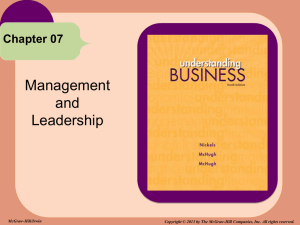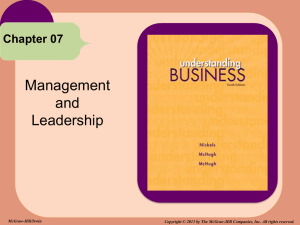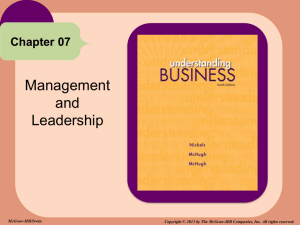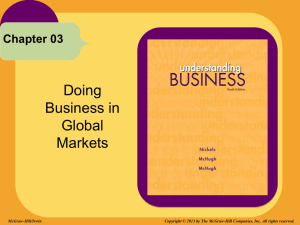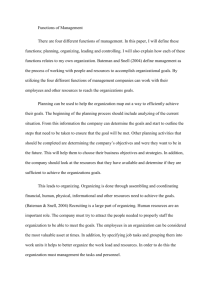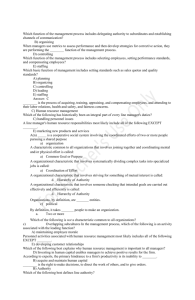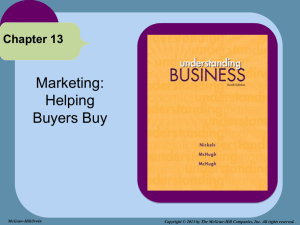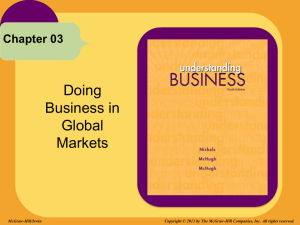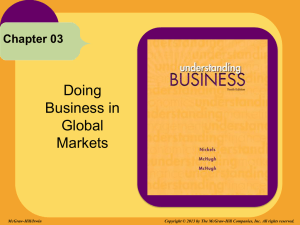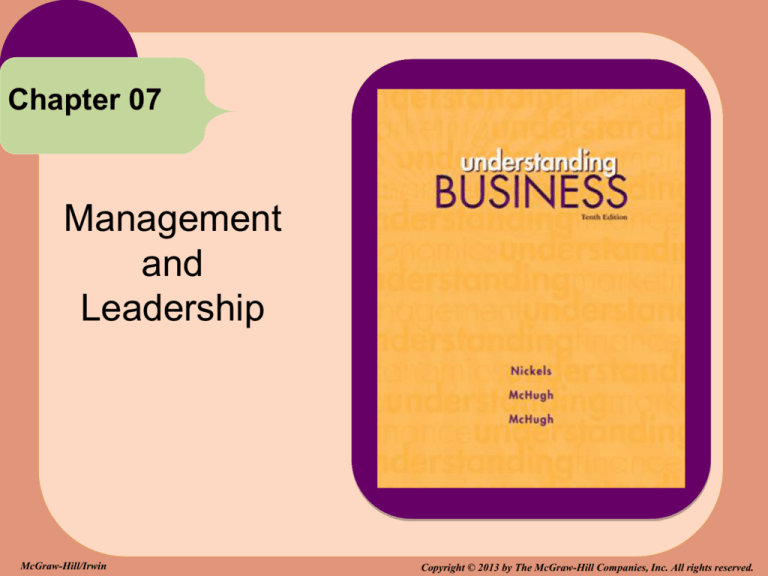
Chapter 07
Management
and
Leadership
McGraw-Hill/Irwin
Copyright © 2013 by The McGraw-Hill Companies, Inc. All rights reserved.
Chapter Seven
LEARNING GOALS
1. Describe the changes occurring today in the
management function.
2. Describe the four functions of management.
3. Relate the planning process and decision making
to the accomplishment of company goals.
7-2
Chapter Seven
LEARNING GOALS
4. Describe the organizing function of management.
5. Explain the differences between leaders and
managers, and describe the various leadership
styles.
6. Summarize the five steps of the control function of
management.
7-3
Four Functions
of Management
WHAT IS MANAGEMENT?
LG1
• Management -- The process used to accomplish
organizational goals through planning, organizing,
leading and controlling people and other
organizational resources.
7-4
Managers’ Roles
Are Evolving
TODAY’S MANAGERS
LG1
• Younger and more
progressive
- Growing numbers of women
- Fewer from elite universities
• Emphasis is on teams and
team building
• Managers need to be skilled
communicators and team
players
7-5
Managers’ Roles
Are Evolving
RESPECT and HOW to GET IT
LG1
Source: Entrepreneur, www.entrepreneur.com, accessed June 2011.
7-6
Managers’ Roles
Are Evolving
EDUCATION MATTERS
Alma Maters of CEOs
LG1
Rank
School
# of CEOs
Who?
1
University of California
12
William Johnson - Heinz
2
School of Hard Knocks*
12
Steve Jobs - Apple
3
Harvard College
11
Steve Ballmer - Microsoft
4
University of Missouri
11
David Novak - Yum! Brands
5
University of Texas
11
Gary Kelly - Southwest Airlines
6
University of Wisconsin
11
Carol Bartz - Yahoo!
7
Dartmouth College
10
Enrique Salem - Symantec
8
Princeton
8
Andrea Jung - Avon Products
9
Indiana University
8
Donald Knauss - Clorox
10
Purdue University
8
Gregory Wasson - Walgreen’s
* Did not graduate from any college or university.
Source: Bloomberg BusinessWeek, May 17, 2010.
7-7
Four Functions
of Management
LG2
FOUR FUNCTIONS of
MANAGEMENT
1. Planning:
Setting goals
2. Organizing: Creating structure
3. Leading:
Guiding & motivating
4. Controlling: Measuring results
7-8
Planning &
Decision Making
LG3
1. PLANNING
SHARING the VISION
Planning: Anticipating
trends and determining
the best strategies and
tactics to achieve
organizational goals and
objectives
Vision: More than a goal;
encompasses why the
organization exists and
where it’s trying to go.
7-9
Planning &
Decision Making
LG3
1. PLANNING
DEFINING THE MISSION
• Mission Statement -- Outlines the organization’s
fundamental purposes. It includes:
-
The organization’s self-concept
Its philosophy
Long-term survival needs
Customer needs
Social responsibility
Nature of the product or service
7-10
Planning &
Decision Making
LG3
1. PLANNING
SETTING GOALS & OBJECTIVES
• Goals -- The broad, long-term
accomplishments an
organization wishes to attain.
• Objectives -- Specific, shortterm statements detailing how
to achieve the organization’s
goals.
7-11
Planning &
Decision Making
LG3
1. PLANNING
FUNDAMENTAL QUESTIONS
Planning is a continuous process, therefore ask:
What is the situation now?
SWOT Analysis -- Analyzes the organization’s
Strengths, Weaknesses, Opportunities and Threats.
How can we get to our goal from here?
- Strategic planning
- Tactical planning
- Operational planning
- Contingency planning
7-12
Planning &
Decision Making
SWOT ANALYSIS (MATRIX)
LG3
Potential Internal
STRENGTHS
Potential Internal
WEAKNESSES
Potential External
OPPORTUNITIES
Potential External
THREATS
7-13
Planning &
Decision Making
PLANNING FUNCTIONS
LG3
7-14
Planning &
Decision Making
LG3
STRATEGIC and TACTICAL
PLANNING
• Strategic Planning -- Done by top
management. Determines the major
goals of the organization and the
policies, procedures, strategies and
resources needed to achieve them.
• Tactical Planning -- The process
of developing detailed, short-term
statements about what is to be done,
who is to do it and how.
7-15
Planning &
Decision Making
LG3
OPERATIONAL and CONTINGENCY
PLANNING
• Operational Planning -- The process of setting
work standards and schedules necessary to
implement the company’s tactical objectives.
• Contingency Planning -The process of preparing
alternative courses of action
the firm can use if its primary
plans don’t work out.
7-16
JAPANESE CRISIS, TERRORISM,
and AMERICAN BUSINESS
(Reaching Beyond Our Borders)
• Disasters point out the need for contingency and
disaster planning.
• Over 30 U.S. corporations get at least 15% of
sales from Japan. All were affected by the
earthquake.
• Man-made disasters, such as war and terrorism,
also disrupt the supply chain.
7-17
Decision Making:
Finding the Best
Alternative
DECISION MAKING
LG3
Decision Making: Choosing among two or
more alternatives. 7 STEPS-1. Define the situation
2. Describe and collect needed information
3. Develop alternatives
4. Develop agreement among those involved
5. Decide which alternative is best
6. Do what is indicated
7. Determine if the decision was good and follow up
7-18
Decision Making:
Finding the Best
Alternative
PROBLEM SOLVING
LG3
• Problem Solving: The process
of solving everyday problems
that occur; less formal than
decision making and involves
quicker action.
• Problem-solving techniques
include brainstorming and PMI Listing all the pluses for a
solution in one column, all the
minuses in another and the
implications in a third.
http://www.mindtools.com/pages/article/newTED_05.htm
7-19
Organizing:
Creating a
Unified System
LG4
2. ORGANIZING
ORGANIZATIONAL CHARTS
• Organization Chart –
A visual device that
shows relationships
among people and
divides the organization’s
work; it shows who is
accountable and who
reports to whom.
7-20
Creating a
Unified
System
LEVELS of MANAGEMENT
Top
Management
Division Heads,
Branch Mgrs
President,
Vice Presidents
Middle Management
Supervisory (First-Line)
Foremen, Dept
Heads
Employees
Non-supervisory
7-21
Organizing:
Creating a
Unified System
MANAGEMENT LEVELS
LG4
• Top Management -- The highest level, consists
of the president and other key company executives
who develop strategic plans.
• Middle Management -- Includes general
managers, division managers, and branch and
plant managers who are responsible for tactical
planning and controlling.
• Supervisory Management -- Those directly
responsible for supervising workers
and evaluating daily performance.
7-22
Organizing:
Creating a
Unified System
TOP MANAGEMENT
LG4
• Chief Executive Officer (CEO)
- Introduces change into
an organization.
• Chief Operating Officer (COO)
- Implements CEO’s changes.
• Chief Financial Officer (CFO)
- Obtains funds, plans budgets, collects funds, etc.
• Chief Information Officer (CIO)
- Gets the right information to the right people so
decisions can be made.
7-23
Organizing:
Creating a
Unified System
LG4
AMERICA’S MOST POWERFUL
FEMALE MANAGERS
Rank
Name
Organization
1
Indra Nooyi
PepsiCo
2
Irene Rosenfeld
Kraft Foods
3
Patricia Woertz
Archer Daniel Midland
(ADM)
4
Angela Braly
WellPoint
5
Andrea Jung
Avon Products
6
Oprah Winfrey
Harpo and OWN
7
Ellen Kullman
DuPont
8
Ginni Rommetty
IBM
9
Ursula Burns
Xerox
10
Carol Bartz
Yahoo!
Source: Fortune Magazine, www.fortune.com, accessed June 2011.
7-24
Tasks and Skills
at Different Levels
of Management
MANAGERIAL SKILLS
LG4
• Technical Skills -- The ability to
perform tasks in a specific
discipline or department.
• Human Relations Skills -- Skills
that involve communication and
motivation; they enable managers
to work through and with people.
• Conceptual Skills -- Skills that
involve the ability to picture the
organization as a whole and the
relationship among its parts.
7-25
Tasks and Skills
at Different Levels
of Management
LG4
SKILLS NEEDED at VARIOUS
LEVELS of MANAGEMENT
7-26
Staffing: Getting
and Keeping the
Right People
STAFFING
LG4
• Staffing -- Recruiting, hiring, motivating and
retaining the best people available to accomplish
the company’s objectives.
• Recruiting good
employees is critical.
• Many people are not
willing to work at
companies unless they
are treated well with
fair pay.
7-27
Staffing: Getting
and Keeping the
Right People
STAFFING is TRICKY BUSINESS
LG4
Six Sins of Staffing
1. Don’t hire someone because someone else says so.
2. Don’t get caught up in applicants’ appearances.
3. Don’t give someone the wrong job.
4. Don’t forget about feedback.
5. Don’t give promotions just because it’s time.
6. Don’t cheat your employees.
Source: CareerBuilder, www.careerbuilder.com, accessed June 2011.
7-28
Leading: Providing
Continuous Vision
and Values.
3. LEADING
LG5
• Leaders must:
- Communicate a vision and
rally others around that vision
- Establish corporate values
- Promote corporate ethics
- Embrace change
- Stress accountability and
responsibility (transparency)
7-29
Leading: Providing
Continuous Vision
and Values.
LG5
ACCOUNTABILITY through
TRANSPARENCY (Ch. 4)
• Transparency -The presentation of
the company’s facts
and figures in a way
that is clear and
apparent to all
stakeholders.
Edward Snowden-NSA/CIA
Sherron Watkins-Enron
7-30
Leadership
Styles
LEADERSHIP STYLES
LG5
• Autocratic Leadership: Making
managerial decisions without
consulting others. (Sports)
• Participative or Democratic
Leadership: Managers and
employees work together to make
decisions. (FedEx, ATT)
• Free-Rein Leadership: Managers
set objectives and employees are
free to do whatever is appropriate
to accomplish those objectives.
(Best Buy, Google)
7-31
Leadership
Styles
VARIOUS LEADERSHIP STYLES
LG5
7-32
Empowering
Workers
EMPOWERMENT
LG5
• Progressive leaders give employees authority to
make decisions on their own without consulting a
manager.
• Customer needs are handled quickly.
• Manager’s role becomes less of a boss
and more of a coach.
• Enabling: Giving workers the
education and tools they need
to make decisions.
7-33
Empowering
Workers
LG5
WORK SMARTER
How to Ease Pressure on Workers
• Manage output instead of hours.
• Train workers to be ready for a more complex
corporate structure.
• Allow lower-level managers to make decisions.
• Use new technology to foster teamwork.
• Shift hiring emphasis to collaboration.
Source: Bloomberg BusinessWeek, www.businessweek.com.
7-34
Managing
Knowledge
MANAGING KNOWLEDGE
LG5
Knowledge Management:
• Finding the right information,
keeping the information in an
accessible place and making
the information known to
everyone in the firm.
• Is useful to prevent workers from
“reinventing the wheel.”
7-35
Controlling:
Making Sure it
Works
LG6
MANAGING KNOWLEDGE (con’t)
“Knowledge is Power”
1. What do you need to know about your
customers?
2. What about the competition?
3. What would make the company more effective ?
4. What do I still not know AND who should I ask?
5. What is working and what is NOT working??
7-36
Controlling:
Making Sure it
Works
4. CONTROLLING
The control function involves:
Measuring performance relative to planned
objectives and standards, rewarding work well
done and taking corrective action as necessary.
7-37
Controlling:
Making Sure it
Works
4. CONTROLLING
LG6
Control Consists of:
1. Establishing clear performance standards
2. Monitoring and recording actual results
3. Comparing results against standards
4. Communicating results to employees
5. Taking corrective action when needed AND
6. Providing positive feedback
for work well done
7-38
Controlling:
Making Sure it
Works
ARE YOU a MICROMANAGER?
LG6
• Do you have strategic initiatives that you have
not addressed?
• Do you often check on employees for quality
control?
• Do you often check on subordinates throughout
the day?
• Do you rarely take vacations?
• Is there a lot of turnover?
Source: CFO Magazine, www.cfo.com.
7-39
A Key Criterion
for Measurement:
Customer
Satisfaction
MEASURING SUCCESS
LG6
• Financial: Traditional form of measuring success
• However, pleasing employees, stakeholders and
customers is important!
• External Customers -- Dealers, who buy products
to sell to others, and ultimate customers (or end
users), who buy products for their own use.
• Internal Customers -- Individuals and units within
the firm that receive services from other individuals or
units. (for ex. Sales Personnel)
7-40
A Key Criterion
for Measurement:
Customer
Satisfaction
LG6
MANAGEMENT CONCERNSCURRENT TRENDS
•Globalization
•Improving Knowledge Management
•Cost and Cycle Time Reduction
•Improving Global Supply Chains
•Manufacturing at Multiple Locations/Many Countries
•More Part-time, Temporary and Contract Workers
7-41
Progress
Assessment
IN CONCLUSION
• What is the difference between goals and
objectives?
• What does a company analyze when it does a
SWOT analysis?
• Name three different types of leadership styles.
• What are some traits of good leaders?
7-42

